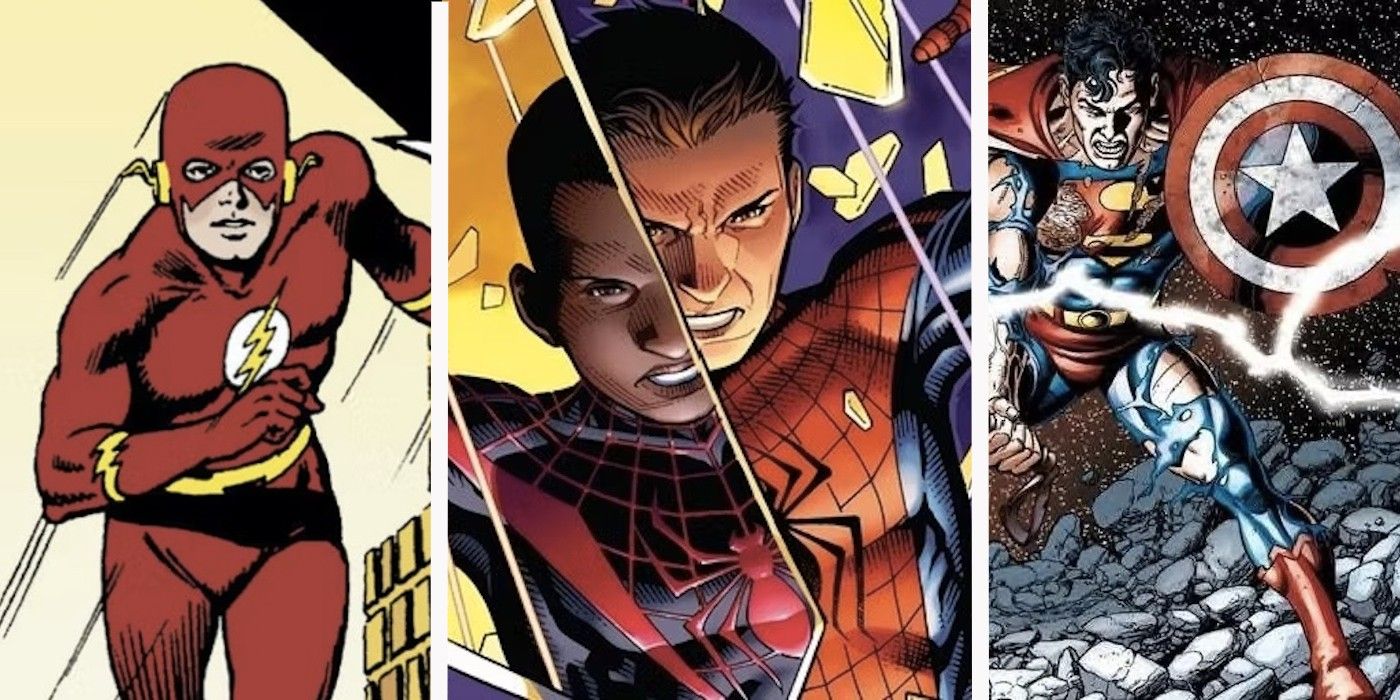With the recent craze for multiversal storytelling, now is a great time to look back to the parallel universe stories from comics that paved the way. From groundbreaking stories of the 1960s like “Flash of Two Worlds!” to modern epics such as Jonathan Hickman’s work on New Avengers, this classic science fiction element forces characters into introspection through an external foil.
The parallel universe provides a narrative way to create a foil for the characters and the world of the hero, upping the stakes from a simple antagonizing external conflict to one that forces the protagonist to ask moral or philosophical questions. The stories below attempt to draw a through line of how each story builds upon the last within a genre convention across the past 60+ years.
10 The Flash #123: “Flash of Two Worlds!” by Gardner Fox and Carmine Infantino
1961’s “Flash of Two Worlds!” by Gardner Fox and Carmine Infantino is a landmark story introducing the multiverse to the DC Universe, in which the Flash of the 1960s, Barry Allen, accidentally travels to a parallel world. There he meets Jay Garrick, who on Barry’s Earth is a fictional 1940s comic book character named the Flash, and whose comics inspired Barry to become a hero. They team up to stop a trio of Jay’s former adversaries, prompting Jay to come out of retirement. Combining speculative science fiction with nostalgia for the Golden Age, “Flash of Two Worlds!” is pure Silver Age imagination and continues to influence DC Comics to today.
9 The Adventures of Luther Arkwright by Bryan Talbot
Bryan Talbot’s The Adventures of Luther Arkwright was a quiet formal and narrative leap forward in western comic books, inspiring a whole host of talent that emerged in the comic book landscape of the ’80s and ’90s. The story follows Luther Arkwright, a secret agent with the ability to jump between universes. He works for a multiversal security force attempting to combat the fascistic Disruptors, with both organizations searching for a power that could spell the apocalypse. Talbot aimed to create the most sophisticated comic of his career, and it shows, from the Victorian etching inspired artwork, the interspersion of news and art excerpts, nonlinear storytelling, and the dense, politically charged plot.
8 StormWatch: “Bleed” by Warren Ellis, Bryan Hitch, and Michael Ryan
Warren Ellis’ StormWatch follows the UN-funded peacekeeping superhero team StormWatch, an all powerful group allowed to act with near unlimited impunity. In “Bleed” they discover a parallel world that they realize will soon be attacked by an alien invasion. The parallel world is similar to StormWatch’s, but technologically behind, and unaware of the incoming invasion. When StormWatch realizes they could potentially provide aid, they are confronted with the question of whether they possess the moral authority to alter a universe’s history. Ellis followed up on the questions posed in “Bleed” in his sequel series The Authority, during the arc “Shiftships,” in which StormWatch’s own world is invaded by a parallel reality.
7 JLA: Earth 2 by Grant Morrison and Frank Quitely
In Earth 2 a heroic Alexander Luthor appears to ask the JLA for aid in saving his home world, a parallel Earth from the antimatter universe, from their despotic rulers, the despotic Crime Syndicate of America, evil mirrors of the JLA. The JLA travel to the parallel Earth to make things right, but Morrison uses the conceit of an antimatter universe to turn everything on its head. This includes narrative convention: whereas on the main Earth of the DCU the good guys always win, on the antimatter Earth, the same is true for evil. The JLA are confronted with a world whose storytelling rules prevent them from ever coming out on top.
6 JLA/Avengers by Kurt Busiek and George P?rez
JLA/Avengers sees the DC villain Krona on a quest destroying universes to discover the truth of creation. In an effort to stall him and save the Marvel Universe, the Grandmaster challenges Krona to a game, pitting the Avengers of his universe against the JLA of Krona’s Earth. It’s a seemingly predictable set-up, which allows Busiek and P?rez to build suspense towards the expected fan service, but a major twist halfway through throws readers into a wildly creative unknown. The crossover contains some of P?rez’s most exciting layouts, expressions, and dense penciling, and Busiek loads the book with satisfying fanboy moments deepened by expert characterization.
5 Spider-Men by Brian Michael Bendis and Sara Pichelli
One of the key inspirations behind Into the Spider-Verse, Spider-Men sees the first meeting between the original Spider-Man Peter Parker and Miles Morales, the Spider-Man of the Ultimate Universe, when Mysterio traps Peter on the alternate Earth. The series marks the first crossover between Marvel’s original main universe and the younger Ultimate Universe, which debuted in 2000. Long-time Ultimate Spider-Man writer Brian Michael Bendis confronts Miles with a version of the dead idol he never met, and Sara Pichelli’s masterful line work is pitch perfect for capturing the script’s blend of comedy and drama.
4 Manhattan Projects #20 by Jonathan Hickman, Nick Pitarra, and Jordie Bellaire
Manhattan Projects is set in a world where building the atomic bomb was a front for a whole host of secret science-fiction-inspired projects run by delightfully twisted versions of famous scientists. These scientists include Albrecht Einstein, an alternate universe variant who replaced the real Albert Einstein after Albert built a Gateway to travel between dimensions and Albrecht stepped through. Issue 20 sees Albert return, and recounts his escape from the fantasy-inspired hellscape from which Albrecht originated. With imagery of Einstein wielding a trident while riding a hammerhead shark to take on an evil King Oppenheimer as a wily magician, this is Manhattan Projects at both its most hilarious and badass.
3 New Avengers: “A Perfect World” by Jonathan Hickman, Rags Morales, Valerio Schiti, and Kev Walker
Jonathan Hickman’s extended stay at Marvel saw intersecting stories across his runs on The Fantastic Four and Avengers books, culminating in Secret Wars, telling the tale of a multiversal collapse from different universes colliding with each other at the touchpoint of Earths. If the Earths collide, both universes are destroyed. “A Perfect World” from New Avengers #16 to #23 sees Marvel’s heroes encounter a Justice League style group from a more hopeful world. The story is the culmination of the moral conflicts the Illuminati have been faced with throughout Hickman’s run, confronting them with an impossible decision; will they sacrifice one of the Earths to save both universes?
2 Transformers: Lost Light: “Dissolution” by James Roberts and Jack Lawrence
“Dissolution” from Lost Light #1-5 sees Rodimus and his team accidentally teleport to a parallel version of their home planet Cybertron, one where Megatron never started the Autobot-Decepticon war. The group encounter a fascist society built around a rigorous caste system in which the Transformers with the most valuable alternate-modes receive wealth and safety, while those deemed useless are quietly murdered. Any who try to speak out are mutilated and silenced. Slowly built up throughout the preceding series, More than Meets the Eye, “Dissolution” brings into full focus author James Roberts’ use of the Transformers concept to explore political and philosophical ideas about societal and economic worth.
1 Peter Cannon: Thunderbolt by Kieron Gillen and Caspar Wijngaard
A meta textual analysis on the effects of Watchmen on comics, Kieron Gillen’s Peter Cannon sees the superhero world of Peter Cannon invaded by a grim and gritty post-apocalyptic alternate version of himself. With Peter Cannon’s superpower being the knowledge of the formal comic book structure of his world, this experimental adventure sees Gillen commentating on the western comic book form via literalized metaphors. Simultaneously a love letter to and a reckoning with Watchmen, the conflict is not simply between Peter Cannon and his cynical alternate self, but between what comics have the potential to be and the anemic urge to imitate one landmark superhero book from the 1980s.
In asking the protagonist to reflect upon their own world, stories of parallel universes prompt the readers themselves to do the same. Stories of alternate histories ask us to critically reexamine the foundations upon which our society was built, dystopian and utopian parallels prompt us to question where we might have gone wrong. Parallel versions of a protagonist spur readers to reconsider how humans can be functions of their circumstances. Parallel universes in fiction externalize the experience of reading a good story, in which the discovery of a new world forces us to look back at our own.
Influential parallel universe stories from comics. Read More

